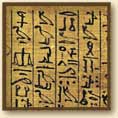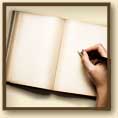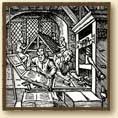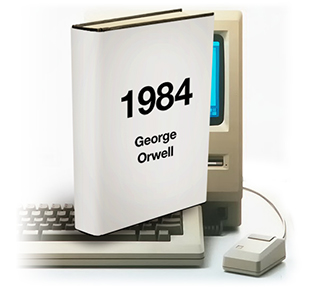Comments:
0 |
Posted by: dcorpsmen
The World Is Changing
The world of books is changing, and along with it the publishing industry. We can see this in a myriad of details: sales of traditional books are down 25% across the board, sales of e-books are up 160%, Borders has closed and other book store chains are struggling. These changes are often attributed to the growing use of e-readers. But even before the Kindle took off there were already other factors that could be considered game changers: a sluggish economy, the rise of the super stores, the growing popularity of Amazon, and more. And these “game-changers” did not just affect book stores. They also affected publishers and those of us who love and work with books.
To help us put all these modern changes in perspective we thought it would be a good exercise to look back at history and review the adaptations, inventions, and other changes that have affected writing, reading, and publishing throughout the ages.
A Brief History of Writing, Reading & Publishing
 1. Pictographic writing (developed between 7,000 BC and 4,000 BC) — first as mnemonic symbols which became ideograms or pictographs. “The Sumerian archaic cuneiform script and the Egyptian hieroglyphs are generally considered the earliest true writing systems, both emerging out of their ancestral proto-literate symbol systems from 3400–3200 BC with earliest coherent texts from about 2600 BC.” (2)
1. Pictographic writing (developed between 7,000 BC and 4,000 BC) — first as mnemonic symbols which became ideograms or pictographs. “The Sumerian archaic cuneiform script and the Egyptian hieroglyphs are generally considered the earliest true writing systems, both emerging out of their ancestral proto-literate symbol systems from 3400–3200 BC with earliest coherent texts from about 2600 BC.” (2)
 2. Paper (2400 BC) — “The word “paper” is etymologically derived from papyros, Ancient Greek for the Cyperus papyrus plant.” (3) “Papyrus ( /pəˈpaɪrəs/) is a thick paper-like material produced from the pith of the papyrus plant, Cyperus papyrus, a wetland sedge that was once abundant in the Nile Delta of Egypt.” (4)
2. Paper (2400 BC) — “The word “paper” is etymologically derived from papyros, Ancient Greek for the Cyperus papyrus plant.” (3) “Papyrus ( /pəˈpaɪrəs/) is a thick paper-like material produced from the pith of the papyrus plant, Cyperus papyrus, a wetland sedge that was once abundant in the Nile Delta of Egypt.” (4)
 3. First alphabet (1800 BC) — “West Semitic people from the eastern coast of the Mediterranean (where Phoenician and Hebrew groups lived) are usually credited with developing the world’s first alphabet.” (5) “The early alphabetic writing systems of Mesopotamia, such as the Phoenician alphabet, had only signs for consonants.” (6) Technically this meant it was not a true ‘alphabet’ in the narrow sense but a syllabic (glyphs represent syllables) because letters did not represent vowels and consonants.
3. First alphabet (1800 BC) — “West Semitic people from the eastern coast of the Mediterranean (where Phoenician and Hebrew groups lived) are usually credited with developing the world’s first alphabet.” (5) “The early alphabetic writing systems of Mesopotamia, such as the Phoenician alphabet, had only signs for consonants.” (6) Technically this meant it was not a true ‘alphabet’ in the narrow sense but a syllabic (glyphs represent syllables) because letters did not represent vowels and consonants.
 4. Vowels (800 BC) — “The Greek alphabet for the first time introduces vowel signs.” (7) This is thought to have come about in order “to transcribe the meter (dactylic hexameters) of the great epics, Iliad and Odyssey, attributed to Homer, and the works of Hesiod.” (5)
4. Vowels (800 BC) — “The Greek alphabet for the first time introduces vowel signs.” (7) This is thought to have come about in order “to transcribe the meter (dactylic hexameters) of the great epics, Iliad and Odyssey, attributed to Homer, and the works of Hesiod.” (5)
 5. The codex (between 100 AD and 400 AD) — The book, before its modern form, was a continuous roll. Today’s codex form, multiple pages bound together between a hard cover, is more convenient than the scroll for finding information quickly, as well as for carrying and storage. (8)
5. The codex (between 100 AD and 400 AD) — The book, before its modern form, was a continuous roll. Today’s codex form, multiple pages bound together between a hard cover, is more convenient than the scroll for finding information quickly, as well as for carrying and storage. (8)
 6. Spaces between words (7th century AD) — The earliest Greek inscriptions used interpuncts, as was common in the writing systems preceded it, but soon the practice of scriptio continua, continuous writing in which all words ran together without separation became common.” … (in Medieval times) “the Greek style of scriptio continua became fashionable. In the 7th century Irish monks started using blank spaces, and introduced their script to France. By the 8th or 9th century spacing was being used fairly consistently across Europe (Knight 1996).” (6)
6. Spaces between words (7th century AD) — The earliest Greek inscriptions used interpuncts, as was common in the writing systems preceded it, but soon the practice of scriptio continua, continuous writing in which all words ran together without separation became common.” … (in Medieval times) “the Greek style of scriptio continua became fashionable. In the 7th century Irish monks started using blank spaces, and introduced their script to France. By the 8th or 9th century spacing was being used fairly consistently across Europe (Knight 1996).” (6)
 7. Printing press (around 1440 AD) — “The Western book was no longer a single object, written or reproduced by request. The publication of a book became an enterprise, requiring capital for its realization and a market for its distribution.” (8)
7. Printing press (around 1440 AD) — “The Western book was no longer a single object, written or reproduced by request. The publication of a book became an enterprise, requiring capital for its realization and a market for its distribution.” (8)
8. Steam printing press and steam paper mills (before 1820 AD) “Together, they caused book prices to drop and the number of books to increase considerably.” (8)
 9. First e-book (1971 AD) — “Among the earliest general e-books were those in Project Gutenberg, in 1971.”(9)
9. First e-book (1971 AD) — “Among the earliest general e-books were those in Project Gutenberg, in 1971.”(9)
10. Digital printing (1993 AD) — “The main difference between digital printing and traditional methods…is that no printing plates are used, resulting in a quicker and less expensive turn around time.”(10)
The E-Book and the Continuing
Need for Design Excellence
The innovations in the history of writing, reading, and publishing can be seen as innovations in handling ‘information’. Therefore, we can divide publishing into the following four sub-categories:
– content development of books (writing and design of communication),
– production of books,
– sale and transmission of books,
– and storage of books.
At Design Corps we are, of course, primarily concerned with the first sub-category — design of communication. With the latest digital technological changes, such as the e-book, the last three sub-categories are greatly advanced — cost of materials can be reduced, transportation can be done over the internet, and storage is achieved on any hard drive. But in the first subcategory, the area of communication design, it may be argued that there have been a few setbacks.
• First, with the quick proliferation of many titles there is the complaint that e-books contain many distracting typos. Hopefully this is just an aspect of the rush to market. One would expect this if the titles published with typos only including those old public domain titles that have been scanned and sold to make a quick buck. But some have complained of the same lack of attention to detail in new best sellers. Since proofreading does not change whether books are printed or published digitally we hope this is a momentary lapse attributable to massive changes in publishing.
• Second, in terms of layout e-books can be compared to the first web sites. They offer many benefits at the expense of design. Design is not just art for art’s sake but, rather, the crafting of the presentation of information to make it more accessible, interesting, and navigable for the human mind. In other words, there is something lost in e-books compared to traditional print books when it comes to page design for clear communication. The good news is that, as we have seen with any other technology from web sites to i-pods, design will be introduced as software improves.
• Third, digital books can introduce elements to reading that may enrich reading but also distract. Advantages like links, easy to scroll through text, and instant comments may increasingly sacrifice our ability to give the text our focused attention. As Steve Johnson wrote:
““I fear that one of the great joys of book reading — the total immersion in another world, or in the world of the author’s ideas — will be compromised. We all may read books the way we increasingly read magazines and newspapers: a little bit here, a little bit there.…This fragmentation sounds unnerving — yet another blow to the deep-focus linearity of the print-book tradition. Breaking the book into detachable parts may sell more books, but there are certain kinds of experiences and arguments that can only be conveyed by the steady, directed immersion that a 400-page book gives you.” (1)
But we believe e-books will go the way that the history of writing, the history of books, even the history of web sites has gone. In all of these the technology advanced to allow design to better organize information to be more easily understood by readers. At Design Corps we are committed to “TURNING INFORMATION INTO COMMUNICATION”. That is the fundamental role of all design, especially book design, and it is especially needed in this era of these transformative recent technologies.
(1) — (http://online.wsj.com/article/SB123980920727621353.html)
(2) — (http://en.wikipedia.org/wiki/History_of_writing)
(3) — (http://en.wikipedia.org/wiki/Paper)
(4) — (http://en.wikipedia.org/wiki/Papyrus)
(5) — (http://ancienthistory.about.com/od/language/f/1stalphabet.htm)
(6) — (http://en.wikipedia.org/wiki/Word_space)
(7) — (http://en.wikipedia.org/wiki/History_of_writing) and (Millard, A. R. (1986). “The Infancy of the Alphabet”. World Archaeology 17 (3): 390–398. doi:10.1080/00438243.1986.9979978)
(8) — (http://en.wikipedia.org/wiki/History_of_books)
(9) — (http://en.wikipedia.org/wiki/E-book)
(10) – (http://en.wikipedia.org/wiki/Digital_printing)
Read more →


















